-

人教版新目标初中英语七年级下册How was your weekend教案2篇
Teaching Goal:1. General aims:Talk about recent past events2. Particular aims:A. Language Focus.Talk about recent past events and think of the past events.B. Language goalsHow was….?It was …What did …do over the weekend?C. Language structures:(1). How was your weekend? I was great. Pay attention to no form.(2). What did you do over the weekend? I played soccer. We went to the beach.D. Useful words and phrases:Words: was, did, went, beach, over, project, test, wasn’t, false, number, geography, spend, week, most, mixture, their, had, little, cook, read, saw, change, everyone, sit, sat, no, anythingPhrases: did one’s homework, played soccer, cleaned my room, went to the beach, played tennis, went to the movies, on Saturday morning, over the weekend, cook … for, what about, do some reading, have a party, talk show, go shoppingE. Grammar language:Present simple past tenseRegular and irregular verbsF. Learning strategies:Tour and holidaysG. Interdiscipinary:H. Emotion and manner:Teaching time: 5 periodsTeaching procedures:Period One教学步骤、时间 教师活动 学生活动 媒体应用Step 1Free talk 3’ Ask some questions like:Who’s on duty today?What’s the weather like? Answer and talk about something.让同学们回答下列问题1. Do you like weekend? (Let some students answer)It takes them three minutes to talk about the question.2. Why do you like weekend? (let the students answer) Most of the students like the weekend此时教师用汉语问:“在周末期间问你干了什么?这句话用英语这么回答?Let the students guess.At last the teacher give them right answer3. What did you do over the weekend?(板书、学习)

人教版新目标初中英语七年级上册What’s this in English教案
一、知识和能力目标本单元的核心教学内容是“认物”。用英语确认周围的常见事物比较符合英语初学者的实际情况。通过本单元教学,使学生运用所学句型,去熟悉周围事物的名称;教学生学会在实际生活中如何确认事物。通过辨认物体,学生学到一些生词,并巩固所学句型。二、过程和方法目标教师要尽量使学生对课文中出现的句型能够熟练上口,这样,学生才能顺利开展比较灵活的对话。教师可以用手势,表情,动作等示意,帮助学生听懂课堂教学内容,但在实际操作中应尽量避免“明知故问”的倾向,应该采用应用性原则;如:遮盖物品、显露局部、辨认物体、完形识别、图形辨认等方法。三、情感态度和价值观目标目标在学生学习过程中的作用至关重要,教师要帮助他们建立起一个切合自己实际的目标,通过渐进的学习以及一点一滴的进步,使他们逐步建立起成功感。成功越多,自信心就越强。

人教版新目标初中英语七年级下册I ’d like some noodles教案
教学过程Step 1: warming-up Sing a song---------“food and drink” Step 2: Revision1 Dictation2 Revise: What kind of noodles would you like?I’d like …What size bowl of noodles would you like?I’d like…Step 3: Presentation1 show pictures of food, ask students say the words.2 Students read the newspaper ad in 3a. Fill in blanks with words in the box. Then read the ad together, the teacher explains some difficult language points.3 Check the answers Step 4 PracticeAsk students to finish 3b in the same way according to 3a. Students read the short passage and fill in the blanks .At last, check the answers.Step 5 productionAsk students to write their own ad for dumplings, noodles, drinks, and other foods they know. Then ask students to read their partner’s ad. Then order food and drink from their partner.Step 6 Home workGroup work – make an ad about “food and drink”

人教版新目标初中英语七年级下册Where is your pen pal from教案
2.1Match the country with the language.Step II Reading3a? let the students read the letter fast and answer the questions.? Let the students ask more questions about the letter as possible as the can.Step III Writing3b.Step IV. Pairwork2cStep V Listening2a, 2bStep V. HomeworkExercises book(1) P3Exercises book (2) P3Period FourStep I . Dictate the words and sentences in Unit1.Step II. Self-checkStep III. Check the answers for Exercises book in the unit.Step IV. Home workRevise and preparation for unit 2.教学反思:通过本单元的学习,学生基本可以谈论人们的国籍,居住城市及其所说的语言,通过书信方式去介绍自己并寻找笔友。但在涉及到国外的一些城市时,学生对这方面的知识相对欠缺,能介绍的城市并不多,也反应出学生课前预习不充分,这跟学生学习条件也有关,大多数学生无法通过网络获取所需信息。因此,在以后的教学中要多指导学生通过计算机网络获取信息,拓宽知识面。

人教版新目标初中英语八年级上册How do you get to school教案2篇
Step Ⅶ Role play ( Work on 1b)1. First ask two students to read the dialogue to the class.Sa: How do you get to school?Sb: Well, I ride my bike to the subway station. Then I take the subway.2. Now work with a partner.Suppose you use two kinds of transportation to get to school \Hangzhou\Beijing... (bus, train, subway, walking, bike, etc.) Tell how you get there. You may use the phrases in 1a.3. Then ask different pairs of students to present their conversations to the class.Step ⅧListening1. Work on 2a(1) First ask students to read the list of information that Thomas wants to know.…where Nina lives.…how far from school she lives.…how long it takes to get to school.…how she gets to school.…what she thinks of the transportation.(2) Tell students what transportation and bus stop mean.bus stop 汽车站 transportation n. 运送;运输Then tell students we'll hear a recording. Please put a checkmark in front of each thing that Thomas wants to know.(3) Now play the recording for students.( Have students pay attention to the sample answer.) (4) Then correct the answers.

人教版新目标初中英语八年级上册What are you doing for vacation教案2篇
Teaching goals : 1. Words & phrases: babysit ,get back , fishing , rent , think about , decide(on) , tourist etc. 2. How to talk about future plans . 3. 现在进行时表示将来计划或行动. 4. 特殊疑问句(where , when , how long引导) Important and difficult points : Drills :What are you doing for vacation ? I’m watching TV . When are you going ? I’m going … . How long are you staying ? We’re staying for five days . Teaching aids : cards and a tape ,a large wall calendar . Period 1 Teaching procedures : Step 1Leading in1. Free talk . 2. Put up the wall calendar . T: I’m staying home on Saturday (pointing to next Saturday ).Ss repeat . Ss: I’m staying home on Saturday . T: OK. Today we’ll learn how to talk about future plans. Step 2Pre-task SB Page 13 , 1a . 1. Look at the picture carefully and tell what you see in the picture . 2. Write the activities from the pictures in the box and add some more . 3. Practice reading . Step 3While-task1. Using the activities we write in 1a to make conversations .For example :What are you doing for vacation ? I’m visiting my uncle . 2. Pairwork .Practice in pairs . 3. 用第三人称练习对话.

人教版新目标初中英语八年级下册What should I do教案2篇
说明:在帮Li Lei提建议的同时,教育学生如何学好英语。第三课时教学目标1. 语言目标:a) 词汇: Original, in style, haircut, the same as.b) 语言结构:My friend wears the same clothes and has the same haircut as I do.2. 能力目标:大多数学生能够谈论自己喜欢哪种服装,提高查找信息的能力。3. 情感目标:学会如何与朋友相处,要有自己对时尚的看法。教学重点掌握一些重要词汇。教学难点学会谈论问题,并能提出书面建议。◆教学突破首先针对Erin的问题,提出个人的建议,模仿2c部分的对话展开双人交际Pair-work;听老师诵读3a部分的信件,并找出LEFT OUT的问题所在;学生完成3b部分的内容,给Left Out提出书面的建议;学以口头形式提出自己目前存在的某个问题,讲给大家听,让同学们给自己提出一个建议,并作笔录;学生两、三个人分成一组,随意性地进行口语交际,谈论P14的第4部分的某个问题,相互交换意见。

人教版新目标初中英语八年级上册I’m more outgoing than my sister教案2篇
1 交通工具的比较此活动为小组活动。学生通过讨论找出到达某一城市可乘坐的各种交通工具,并选择最佳出行方式。Teacher:We’re going to Shanghai. How many ways can we use to get there? Yes, there are four ways: by bus, by plane, by train, by ship. Please discuss how you are going to get there.操作建议:(1)学生以小组为单位展开活动,谈论本组所选择的交通工具。(2)各组选代表向全班汇报,阐述本组所选择的交通工具的利和弊。完成任务所需要的语言结构:We can go there by ship. It’s more comfortable and cheaper than any other transportation.We can go there by bus. It’s cheaper but it takes longer time.2 哪个城市更合适?此活动具有挑战性。假设中国要举行2014年世界杯足球赛,分别从历史,人文,天气等方面对各城市(北京,大连,上海,昆明)进行比较,选择最佳举办城市。T: Imagine China is holding the 2014 FIFA World Cup. Which city do you think is the best for the World Cup, Beijing, Dalian, Shanghai or Kunming? Let’s work in groups. If you choose Beijing, please join the Team Red. If you chose Dalian, please join the Team White. If you choose Shanghai, please join the Team Blue. If you choose Kunming, please join the Team Green. Please show us its advantages. Then let’s see which team will win.

人教版新目标初中英语八年级下册How long have you been collecting shells教案2篇
Step Ⅱ Show the new words on the screen and teach the new words. Read the new words to students and ask them to repeat.Step Ⅲ 3aThis activity introduces new vocabulary and provides reading practice using the target language.In this activity first look at the four pictures.T: What can you see in the pictures?Ss: Four snow globes.T: Right. There are four snow globes in the pictures. And what are they?Ss: They are a monster, two polar bears, two penguins and a birthday cake.Write these words on the blackboard: snow globe; monster; polar bear; penguin and birthday cake. Read them to the class and ask students to repeat each one. Make sure students understand each word.Use a computer to show the E-mail message on the screen and read the message to students.Get students to read the e-mail on their own, and then draw lines connecting each snow globe and its description.Correct the answers.AnswersA line should connect each snow globe picture with the words that describe it in the letter.Step Ⅳ 3bThis activity provides writing practice using the target language.First review Activity 2a on Page 47.Then ask students to complete the message according to Activity 2a.Some partial sentences are given to students. Write about one person's collection.When students work, walk around the room checking the progress and offering help as needed.When they finish, ask some students to read their messages to the class.

人教版新目标初中英语九年级上册I used to be afraid of the dark教案
内容提示1.本单元主要内容是学会used to结构。Used to +动词原形表示过去经常、以前常常,只用于过去式中,用来表示现在已不存在的习惯或状态。例如:They used to play football together.他们过去常在一起蹋足球。(现在不在一起踢了)2.used to的疑问形式和否定形式为Did you use to…?和I didn’t use to… 也可以用Used you to…?和I used not to…但现在多使用前者。例如:Did you used to swim in the river? 你过去常在河里游泳吗?I didn’t use to play the piano. 我以前并不经常弹钢琴。教学目标一、学习目标(Language Goal) 1.学会陈述自己过去常做的事情。2.学会陈述自己过去的爱好等。3.能够表达自己现在和过去在外表、性格、娱乐等方面的变化。4.能够表达朋友、家人等现在和过去的变化。二、语言结构(Language Structures) 1.I used to be short when I was young. 我年轻时个子很矮。 2. —Did you use to have straight hair? 你过去是直发吗?—Yes, I did. 是的。 3. —Did you use to play the piano? 你过去弹钢琴吗?—No, I didn’t. 不,我不弹。 4.I used to be afraid of dark. 我过去害怕黑暗。 5.I’m terrified of the snakes. 我害怕蛇。
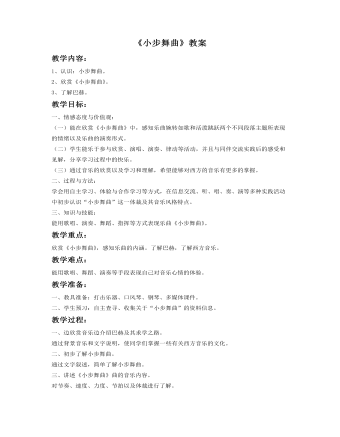
《小步舞曲教案》教案
教学过程:一、边欣赏音乐边介绍巴赫及其求学之路。通过背景音乐和文字说明,使同学们掌握一些有关西方音乐的文化。二、初步了解小步舞曲。通过文字叙述,简单了解小步舞曲。三、讲述《小步舞曲》曲的音乐内容。对节奏、速度、力度、节拍以及体裁进行了解。四、结合谱例分段学习《小步舞曲》。1、学习乐曲A’段。说明:依据乐曲创作背景,合理创设“舞会”情景,从而有效激发学生学习兴趣,用舞蹈表现手段演绎此乐段,发展了学生的舞蹈表演能力,享受到美的愉悦。2、学习乐曲B段。说明:利用形象、直观的图式辅助以及一系列贴近学生思维逻辑的问答讨论,激发学生的思考,帮助学生准确把握乐段情绪,并能用指挥、伴奏等方式表现该乐段。3、完整欣赏《小步舞曲》。说明:学生在完整欣赏乐曲时能够巩固乐曲主题的记忆,并且听辨、感受乐曲两个不同主题情绪,培养学生独立的音乐感受和见解。五、视频欣赏。说明:通过视屏欣赏,使同学们以一个更直观的郊区去理解和学习作品,并使同学对作品有更深刻的记忆。引起学生共鸣,领悟音乐的美感,愉悦身心,获取乐趣,从而激起学习的情趣。
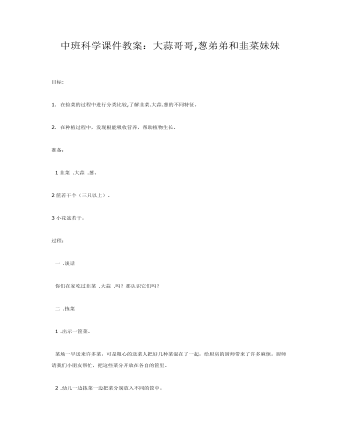
中班科学课件教案:大蒜哥哥,葱弟弟和韭菜妹妹
1. 在捡菜的过程中进行分类比较,了解韭菜.大蒜.葱的不同特征。2. 在种植过程中,发现根能吸收营养,帮助植物生长。准备: 1韭菜 .大蒜 .葱。2筐若干个(三只以上)。3小花盆若干。
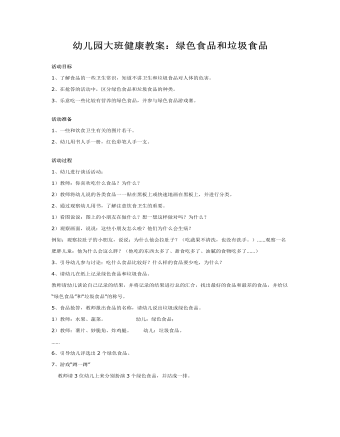
幼儿园大班健康教案:绿色食品和垃圾食品
活动准备 1、一些和饮食卫生有关的图片若干。 2、幼儿用书人手一册,红色彩笔人手一支。活动过程 1、幼儿进行谈话活动: 1)教师:你喜欢吃什么食品?为什么? 2)教师将幼儿说的各类食品一一贴在黑板上或快速地画在黑板上,并进行分类。 2、通过观察幼儿用书,了解注意饮食卫生的重要。 1)看图说说:图上的小朋友在做什么?想一想这样做对吗?为什么? 2)观察画面,说说:这些小朋友怎么啦?他们为什么会生病? 例如:观察拉肚子的小朋友,说说:为什么他会拉肚子?(吃蔬果不清洗,也没有洗手。)……观察一名肥胖儿童:他为什么会这么胖?(他吃的东西太多了、甜食吃多了、油腻的食物吃多了……)

幼儿园大班社会教案:认识文具和学具
活动准备 1、每人准备一只书包、铅笔盒、书本等。 2、情境表演:《两个小朋友》(小学生自己收拾文具的情景,一个会自己收拾,一个不会收拾)活动过程 1、认识学习用品,并知道它们的用途。 ——逐一出示书包、书、铅笔盒、本子、笔、尺、橡皮等用品,并讨论它们的用处。 ——形成学习用品的概念,知道这些都是小学生学习时需要用到的用品。

大班社会教案:我和爷爷奶奶同过节(重阳)
二、活动目的: 1、培养幼儿关心老人的情感。 2、体验与老人同过节的快乐。 1、增进艺术表现能力,学习运用学过的技能,合理地安排画面,画出爷爷奶奶的形象。 三、活动准备: 1、请爷爷奶奶来园参加活动。 2、幼儿自备自己制作的小礼物。 3、幼儿事先排练表演的节目。 4、纸笔幼儿人手各一份。
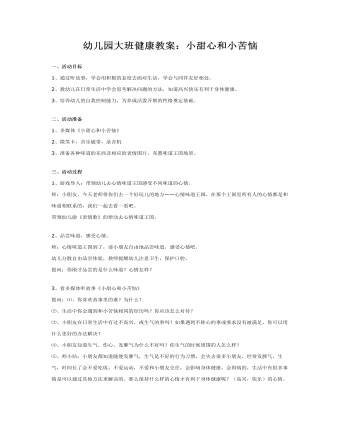
幼儿园大班健康教案:小甜心和小苦恼
二、活动准备 1、多媒体《小甜心和小苦恼》 2、微笑卡,音乐磁带,录音机 3、准备各种味道的东西及相应的表情图片,布置味道王国场景。三、活动过程 1、游戏导入:带领幼儿去心情味道王国感受不同味道的心情。 师:小朋友,今天老师带你们去一个好玩儿的地方——心情味道王国,在那个王国里所有人的心情都是和味道相联系的,我们一起去看一看吧。 带领幼儿做《表情歌》的律动去心情味道王国。2、品尝味道,感受心情。 师:心情味道王国到了,请小朋友自由地品尝味道,感受心情吧。 幼儿分散自由品尝体验,教师提醒幼儿注意卫生,保护口腔。 提问:你刚才品尝的是什么味道?心情怎样?
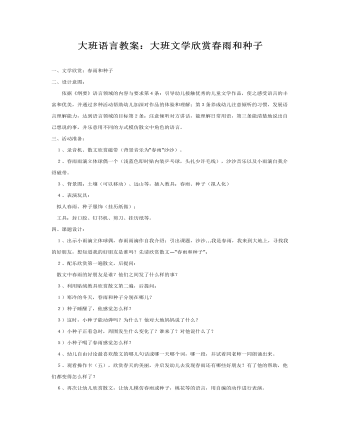
大班语言教案:大班文学欣赏春雨和种子
二、设计意图: 依据《纲要》语言领域的内容与要求第4条:引导幼儿接触优秀的儿童文学作品,使之感受语言的丰富和优美,并通过多种活动帮助幼儿加深对作品的体验和理解;第3条养成幼儿注意倾听的习惯,发展语言理解能力,达到语言领域的目标第2条:注意倾听对方讲话,能理解日常用语,第三条能清楚地说出自己想说的事,并乐意用不同的方式模仿散文中角色的语言。三、活动准备: 1、录音机、散文欣赏磁带(背景音乐为“春雨”沙沙)。 2、春雨雨滴立体球偶一个(浅蓝色即时贴内装乒乓球,头扎少许毛线),沙沙音乐以及小雨滴自我介绍磁带。 3、背景图:土壤(可以移动)、远山等,插入教具:春雨、种子(拟人化) 4、表演玩具: 拟人春雨、种子服饰(挂历纸做); 工具:封口胶、钉书机、剪刀、挂历纸等。
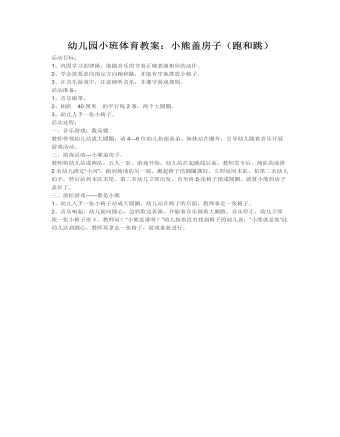
幼儿园小班体育教案:小熊盖房子(跑和跳)
2、学会按要求向指定方向跑和跳,并能有序地摆放小椅子。 3、在音乐游戏中,注意倾听音乐,并遵守游戏规则。 活动准备: 1、音乐磁带、 2、相距 40厘米 的平行线2条,两个大圆圈。 3、幼儿人手一张小椅子。 活动过程: 一、音乐游戏:数高楼 教师带领幼儿站成大圆圈,请4—6位幼儿扮演弟弟、妹妹站在圈外,引导幼儿随着音乐开展游戏活动。
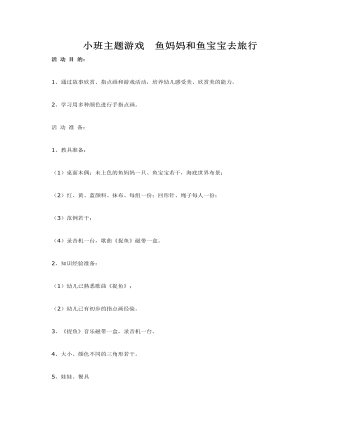
小班主题游戏 鱼妈妈和鱼宝宝去旅行课件教案
2、学习用多种颜色进行手指点画。活动准备:1、教具准备:(1)桌面木偶:未上色的鱼妈妈一只、鱼宝宝若干,海底世界布景;(2)红、黄、蓝颜料、抹布、每组一份;回形针、绳子每人一份;(3)范例若干;(4)录音机一台,歌曲《捉鱼》磁带一盒。2、知识经验准备:(1)幼儿已熟悉歌曲《捉鱼》;(2)幼儿已有初步的指点画经验。
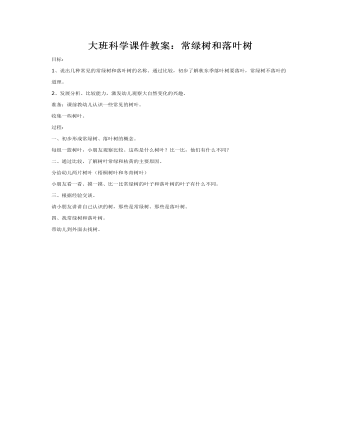
大班科学课件教案:常绿树和落叶树
2、发展分析、比较能力,激发幼儿观察大自然变化的兴趣。准备:课前教幼儿认识一些常见的树叶。收集一些树叶。过程:一、初步形成常绿树、落叶树的概念。每组一篮树叶,小朋友观察比较。这些是什么树叶?比一比,他们有什么不同?

